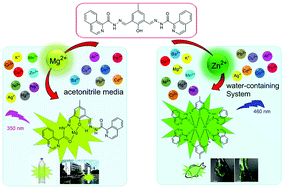A dual functional turn-on non-toxic chemosensor for highly selective and sensitive visual detection of Mg2+ and Zn2+: the solvent-controlled recognition effect and bio-imaging application†
Abstract
A new dual functional turn-on chemosensor, 2,6-diformyl-4-methylphenol-di(isoquinolinyl-1-hydrazone) (HL), has been developed, which could highly selectively discriminate Mg2+ and Zn2+ in different solvent systems. The chemosensor HL exhibits rapid visual turn-on fluorescence enhancing recognition toward Mg2+/Zn2+, which is not interfered by other cations, especially for respective congeners Ca2+/Cd2+. The remarkable fluorescence enhancement (71-fold or 11-fold) was observed after adding Mg2+ in acetonitrile or Zn2+ in DMF–H2O solvent systems. Additionally such a solvent medium-controlled platform could achieve the quantitative determination of Mg2+ and Zn2+ quantitation with low detection limits of 2.97 × 10−8 M and 3.07 × 10−7 M, respectively. Furthermore, the turn-on fluorescence sensing mechanism is also investigated by 1H NMR, FT-IR and ESI-MS spectroscopy. Density functional theory (DFT) calculations derive optimized geometries of HL and its complexes. Notably, non-toxic HL also can be successfully applied as a visual probe for the practical determination of Mg2+/Zn2+ in MCF-7 cells, Zebrafish larvae, syrup and water samples, which might provide extensive application in biology and medicine fields.



 Please wait while we load your content...
Please wait while we load your content...